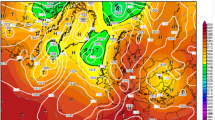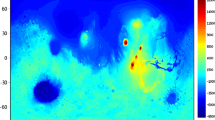Abstract
The three-dimensional mesoscale circulation in the vicinity of the city of São Paulo is examined through model simulations validated by observational data obtained during a field experiment. The complex terrain surrounding the plateau where the city is located, plus proximity to the sea, represent the local controls on the wind field with implications for boundary-layer transport of atmospheric constitutents. The coupling of a regional-scale circulation with slope and sea-breeze circulations is an important feature which determines the wind regime in São Paulo in a summer situation not influenced by frontal systems.
Similar content being viewed by others
References
Bossert, J. E. and Cotton, W. R.: 1994, ‘Regional Scale Flows in Mountainous Terrain. Part I: A Numerical and Observation Comparison’,Mon. Wea. Rev. 122, 1449–1471.
Oliveira, A. P. and Silva Dias, P. L.: 1982, Observational Features of the Sea Breeze in São Paulo. (in Portuguese) II Brazilian Meteorological Congress (Brazilian Meteorological Society) 18–22 October 1982, Proceedings, 2, 129–161.
Paegle, J. and McLawhorn, D. W.: 1983, ‘Numerical Modelling of Diurnal Convergence Oscillations above Sloping terrain’,Mon. Wea. Rev. 111, 67–85
Silva, H. S.: 1986, ‘Study of the Circulation Associated to an Urban Heat Island with a Sea Breeze Simulation Model’. (in Portuguese). Masters Thesis, Department of Atmospheric Sciences, University of Sao Paulo.
Silva Dias, M. A. F.: 1987, ‘Some Applications of the Mesoscale Vorticity Budget’,Proceedings of the IV CONGREMET and II Interamerican Meteorological Congress, 30 Nov-4 Dec., Buenos Aires Argentina.
Silva Dias, M. A. F.: 1988, ‘Effect of Low Level Cloud Wind Motion Vectors Obtained from Satellite on the Mesoscale Vorticity Budget’,V Brazilian Meteorological Congress. (Brazilian Meteorological Society), v. 2, p. VI.11-VI.16.
Silva Dias, P. L., Bonatti, J. P., and Kousky, V. E.: 1987, ‘Diurnally Forced Tropical Tropospheric Circulation over South America’,Mon. Wea. Rev. 115, 1465–1478.
Author information
Authors and Affiliations
Rights and permissions
About this article
Cite this article
Silva Dias, M.A.F., Vidale, P.L. & Blanco, C.M.R. Case study and numerical simulation of the summer regional circulation in São Paulo, Brazil. Boundary-Layer Meteorol 74, 371–388 (1995). https://doi.org/10.1007/BF00712378
Revised:
Issue Date:
DOI: https://doi.org/10.1007/BF00712378




